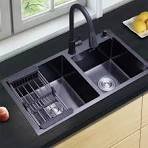How to Choose the Right Kitchen Sink Design for Functionality and Style
The kitchen sink is no longer just a place to wash dishes—it’s the centerpiece of your kitchen’s workflow, aesthetic, and functionality. Whether you’re building a new home, renovating an outdated kitchen, or upgrading a few fixtures, choosing the right kitchen sink design can significantly impact how your kitchen looks and functions. With a wide range of styles, materials, installation methods, and features available, the decision goes beyond appearance.
This guide will walk you through everything you need to know about selecting the right kitchen sink design, integrating both functionality and style. From understanding various sink materials and configurations to comparing installation types and offering tips for making the best choice, this article will help you make a confident, informed decision that aligns with modern standards in home construction and interior design—especially in homes focused on smart space usage and modular installations.
Types of Kitchen Sink Designs: Form Meets Function
When it comes to kitchen sink design, there’s no one-size-fits-all. Each type has its advantages depending on the layout of your kitchen, your usage habits, and your personal preferences.
1. Single-Bowl Sink
A single, deep bowl without any dividers, this type is perfect for small kitchens or minimalist interiors. It accommodates large pots and pans easily and offers ample workspace.
2. Double-Bowl Sink
Featuring two compartments, this design offers versatility—one side can be used for washing, the other for rinsing or drying. Some modern versions offer unequal sizes to cater to different needs.
3. Farmhouse or Apron-Front Sink
Known for its rustic charm and forward-facing front panel, this design is ideal for traditional or transitional kitchens. It provides a deep basin and makes dishwashing more ergonomic.
4. Undermount Sink
This style is installed below the countertop level, creating a seamless appearance. It’s easy to clean and highly popular in contemporary kitchen layouts.
5. Top-Mount or Drop-In Sink
Installed above the countertop with visible edges, this is a more budget-friendly option that’s easier to install and replace.
6. Corner Sink
A creative solution for compact spaces, especially in modular kitchens or L-shaped counters. It maximizes unused corner space.
Key Materials: Durability vs. Aesthetics
The material of your kitchen sink plays a vital role in both functionality and aesthetics.
- Stainless Steel: Highly durable, resistant to corrosion, and easy to maintain. Ideal for modern, high-traffic kitchens.
- Granite Composite: Offers a stone-like look and great durability. Resistant to scratches, stains, and heat.
- Porcelain or Fireclay: Adds a classic look, perfect for farmhouse designs. However, it may chip under heavy impact.
- Cast Iron with Enamel Coating: Known for its strength and glossy finish. Heavier and may require additional counter support.
- Copper: Unique and stylish with natural antimicrobial properties, but it requires regular maintenance.
Installation Considerations: Fit Your Space, Meet Your Needs
Your choice of installation will affect not only how the sink looks but also how it interacts with your kitchen counter, plumbing, and cabinetry.
Undermount vs. Top-Mount
- Undermount sinks offer a sleek, modern look and make counter cleanup easier. However, they require professional installation.
- Top-mount sinks are simpler to install and replace, making them a popular choice in rental properties or budget remodels.
Farmhouse Sink Considerations
This type requires a specially designed cabinet. If you’re considering a remodel with structural adjustments, it can be a worthwhile investment for both function and visual appeal.
Integrated Drainboards and Accessories
Some kitchen sink designs now include integrated accessories like cutting boards, drying racks, or colanders. These multi-functional options are especially useful in smaller kitchens where countertop space is limited.
Kitchen Sink Design Comparison Table
| Sink Type | Installation Style | Pros | Ideal For | Average Price Range |
| Single-Bowl | Top/Undermount | Deep space, easy to clean | Small kitchens, minimalists | $100 – $500 |
| Double-Bowl | Top/Undermount | Dual-function use, versatile | Busy kitchens, families | $150 – $700 |
| Farmhouse (Apron Front) | Custom Cabinet | Deep bowl, aesthetic appeal | Rustic/traditional kitchens | $300 – $900 |
| Undermount | Under Counter | Sleek, easy counter cleaning | Modern interiors, seamless look | $200 – $800 |
| Drop-In (Top-Mount) | Countertop | Easy to install/replace | Budget remodels, rentals | $100 – $400 |
| Corner Sink | Corner Cabinet | Space-saving, unique layout | Compact kitchens, L-shape layout | $250 – $600 |
Analysis of Sink Designs: What This Table Tells You
From the table above, it’s clear that functionality, space, and budget are key determining factors when choosing a sink. If you’re focused on affordability and ease of replacement, a drop-in single-bowl sink is ideal. However, for homeowners prioritizing aesthetic and ergonomic features, the farmhouse or undermount sinks make more sense despite their higher installation costs.
A double-bowl sink offers the most practicality for families or those who cook frequently, while a corner sink is a smart solution in tight, modular kitchens where counter space must be optimized. Materials like stainless steel and granite composite strike a good balance between cost and durability, making them common choices in modern sustainable home projects.
Practical Tips: How to Choose the Right Kitchen Sink Design
Here are some actionable guidelines to help you decide:
- Assess Your Kitchen Workflow: Do you cook a lot? Entertain guests often? Need space for dish drying? This will help decide between single, double, or apron-front sinks.
- Match with Countertop Material: Heavier sinks like cast iron need strong countertop support. Undermount sinks pair best with solid-surface countertops like quartz or granite.
- Prioritize Durability: If your kitchen sees heavy use, go for scratch- and heat-resistant materials like stainless steel or granite composite.
- Consider Your Plumbing Configuration: Some sink styles may require relocating plumbing. Check this before making a final decision.
- Think Long-Term Maintenance: Porcelain and copper sinks look great but may require more upkeep. Choose what suits your lifestyle.
- Check Cabinet Compatibility: Apron-front sinks need special cabinetry. Measure carefully before buying.
- Don’t Forget Accessories: Integrated accessories like cutting boards or colanders can enhance functionality and save counter space.
Aligning Sink Selection with Modern Construction
Modern home construction increasingly incorporates modular, space-saving, and environmentally sustainable practices. Kitchen sinks that align with these goals include:
- Undermount or integrated sinks for minimalist design
- Granite composite or recycled stainless steel sinks for sustainability
- Multi-functional sinks with add-ons that reduce the need for additional countertop tools
For builders or homeowners working with construction and civil engineering firms focusing on smart designs, choosing the right kitchen sink complements an efficient home layout and supports long-term value.
Frequently Asked Questions (FAQ)
Q1: What is the most durable kitchen sink material?
A: Stainless steel is one of the most durable and low-maintenance options. Granite composite also offers exceptional durability with a more premium aesthetic.
Q2: What sink design is best for small kitchens?
A: Single-bowl or corner sinks are ideal for small kitchens as they save space while offering enough depth and utility.
Q3: Are farmhouse sinks practical or just stylish?
A: Farmhouse sinks are both stylish and practical. Their deep basin is great for washing large items, but they do require special cabinetry and may be more costly to install.
Q4: Should I choose a top-mount or undermount sink?
A: Top-mount sinks are easier and cheaper to install. Undermount sinks look sleeker and allow easier countertop cleaning but need professional installation and solid countertop material.
Q5: How do I prevent scratches and stains on my sink?
A: Use a protective grid, avoid using abrasive cleaners, and choose materials like granite composite or high-gauge stainless steel that are more resistant to wear and tear.
Q6: Can I install a new sink in an existing countertop?
A: Yes, especially if it’s a top-mount sink. Undermount or farmhouse sinks may require modifications to the counter or cabinet structure.
Conclusion: Make Your Kitchen Sink Work Smarter and Look Better
Choosing the right kitchen sink design is about balancing style, space, budget, and long-term usage. Whether you’re redesigning your kitchen from scratch or making small upgrades, the right sink can transform your kitchen’s functionality and visual appeal.
Look for designs that complement your overall home layout, especially if you’re working with professionals focused on modular home construction or sustainable design practices. Consider your kitchen habits, available space, and desired materials before making a final decision.
Ready to elevate your kitchen design? Start by identifying the sink style that best fits your lifestyle, consult with your architect or builder, and explore high-quality materials and layouts that align with the future of modern living.





